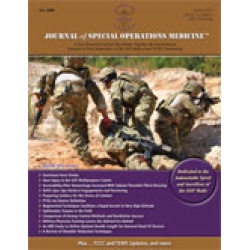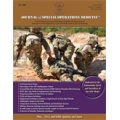Regimented Techniques Facilitate a Rapid Ascent to Very High Altitude: A Controlled Study
Anglim AM, Boyd DW 12(2). 48 - 57 (Journal Article)
Objective: For travel to high altitudes, most experts advise a gradual ascent regimen to prevent acute mountain sickness (AMS). Such standard recommendations are applied to the general public. It is generally thought, however, that those whose work requires frequent rapid ascents, such as military personnel, porters and guides, often make these ascents without adequate preventive measures and then, experience significant morbidity and potential mortality due to AMS. The aim of this study were to demonstrate that the risk of rapid ascents can be mitigated if performed with adherence to a structured nutrition and hydration plan, carrying controlled loads, and taking specific prescribed rest periods during the ascent. Methods: This study used a randomized controlled trial of a group of Nepali porters, guides, and a Westerner with similar characteristics, all participating in their first ascent of the early Himalayan season. Data collected each day included oxygen saturation (SpO(2)), heart rate (HR), weight, and blood pressure (BP). Data was collected every 300 meters(m) (1,000 feet [ft]) and at the same time and altitude at each days end. Ascent profiles, age, gender, ethnic origin, altitude of residence and experience at altitude were also obtained. In four days, a control group of Nepali porters and a Sherpa guide and an equal number of Nepali porters and a Sherpa guide in an intervention group, (led by a Westerner) went from Kathmandu (1,300m), to the summit of Kala Pattar (5,640m), and Everest Base Camp (5,380m), averaging approximately 1,000m (3,500ft) gain a day in altitude, with no acclimatization rest days. During the rapid ascent from 4,300ft to 18,500ft, a regimented program was followed by the intervention group, while the control group ascended using their traditional methods as Nepali porters and Sherpa guides. Values are given as mean ± SE. T-test, ANOVA, and Mann-Whitney tests were used to compare variables. Results: Based on mean SpO(2) measurements on the summit of Kala Pattar at 5,640m (18,500ft), the intervention group had a SpO(2) of 79.5% ± 3.209 and the control group's mean SpO(2) was 74.5% ± 3.109 (ρ = .076). Importantly, two participants dropped out of the control group at 4,900m with SpO(2) scores of 77 and 71. The ANOVA results between the groups SpO(2) at 5,640m was significant at p ≥ .04. Mann Whitney U test results demonstrate a significant (U = 21.5, p = .04) difference in median SpO(2) levels between the intervention and the control groups. This indicates that employing a regimented program is vital to the objective of sustaining adequate SpO(2) levels and yielding a successful climb. The intervention group that followed the regimented nutrition, hydration, and rest period program performed physiologically superior to the control group, especially on the longest (10 hours), highest (5,640m), and greatest altitude gain (1,090m) day-despite resting for five minutes every 25 minutes of hiking. This was achieved with no acclimatization days, and each participant residing at low altitude. Conclusions: Participants who followed a structured nutrition, hydration plan, and adhered to prescribed rest periods, performed physiologically superior to the control group who did not. Two control group participants dropped out with poor physiological measurements. This aggressive ascent profile mirrors encountered work demands on military personnel, professional porters, and guides. The beneficial effect was significant and could provide superior methods to those whose duties require aggressive ascent profiles. The implications of frequent rest periods (10 minutes an hour), a high-carbohydrate diet, and at least 3,000ml of fluid a day appear to factually present a physiologically superior method to trekking at high to very-high altitudes. The health implications for trekkers to the Himalaya (or to any place at high altitude) by using a similar regimented program are that it may allow for an AMS-free, more enjoyable experience at altitude.


 Español
Español 




